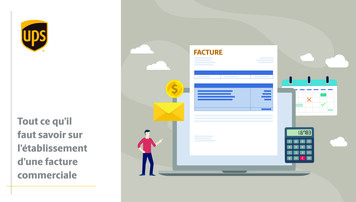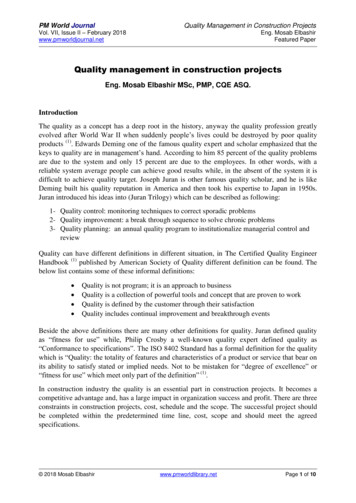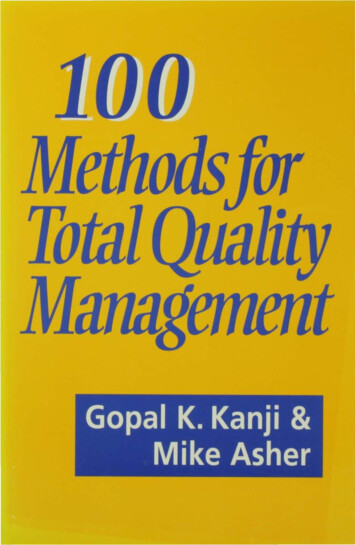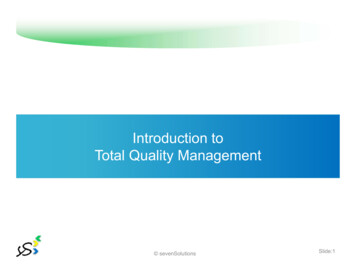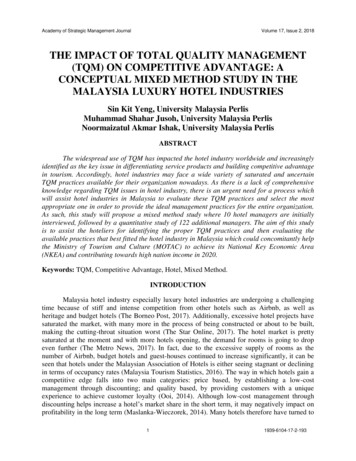
Transcription
Academy of Strategic Management JournalVolume 17, Issue 2, 2018THE IMPACT OF TOTAL QUALITY MANAGEMENT(TQM) ON COMPETITIVE ADVANTAGE: ACONCEPTUAL MIXED METHOD STUDY IN THEMALAYSIA LUXURY HOTEL INDUSTRIESSin Kit Yeng, University Malaysia PerlisMuhammad Shahar Jusoh, University Malaysia PerlisNoormaizatul Akmar Ishak, University Malaysia PerlisABSTRACTThe widespread use of TQM has impacted the hotel industry worldwide and increasinglyidentified as the key issue in differentiating service products and building competitive advantagein tourism. Accordingly, hotel industries may face a wide variety of saturated and uncertainTQM practices available for their organization nowadays. As there is a lack of comprehensiveknowledge regarding TQM issues in hotel industry, there is an urgent need for a process whichwill assist hotel industries in Malaysia to evaluate these TQM practices and select the mostappropriate one in order to provide the ideal management practices for the entire organization.As such, this study will propose a mixed method study where 10 hotel managers are initiallyinterviewed, followed by a quantitative study of 122 additional managers. The aim of this studyis to assist the hoteliers for identifying the proper TQM practices and then evaluating theavailable practices that best fitted the hotel industry in Malaysia which could concomitantly helpthe Ministry of Tourism and Culture (MOTAC) to achieve its National Key Economic Area(NKEA) and contributing towards high nation income in 2020.Keywords: TQM, Competitive Advantage, Hotel, Mixed Method.INTRODUCTIONMalaysia hotel industry especially luxury hotel industries are undergoing a challengingtime because of stiff and intense competition from other hotels such as Airbnb, as well asheritage and budget hotels (The Borneo Post, 2017). Additionally, excessive hotel projects havesaturated the market, with many more in the process of being constructed or about to be built,making the cutting-throat situation worst (The Star Online, 2017). The hotel market is prettysaturated at the moment and with more hotels opening, the demand for rooms is going to dropeven further (The Metro News, 2017). In fact, due to the excessive supply of rooms as thenumber of Airbnb, budget hotels and guest-houses continued to increase significantly, it can beseen that hotels under the Malaysian Association of Hotels is either seeing stagnant or decliningin terms of occupancy rates (Malaysia Tourism Statistics, 2016). The way in which hotels gain acompetitive edge falls into two main categories: price based, by establishing a low-costmanagement through discounting; and quality based, by providing customers with a uniqueexperience to achieve customer loyalty (Ooi, 2014). Although low-cost management throughdiscounting helps increase a hotel’s market share in the short term, it may negatively impact onprofitability in the long term (Maslanka-Wieczorek, 2014). Many hotels therefore have turned to11939-6104-17-2-193
Academy of Strategic Management JournalVolume 17, Issue 2, 2018quality improvement for achieving a competitive advantage marketplace (Dimanche, 2014).Meanwhile, correct implementation of TQM practices could enhance the quality ofproducts/services delivered and enable hotels to remain competitive (Ho, 2010).LITERATURE REVIEWIntroduction to TQMIt is both a philosophy and a series of guiding justifications that are the basis of aceaselessly improving organization (Shweta Bajaj, Ruchi Garg & Monika Sethi, 2018). It intendsto accomplish the effectiveness of the system such as production, design, planning, quality tools,techniques involvement as well as customer satisfaction as it has potential not only to reinforcecompetitiveness but also to strengthen firm effectiveness and produce more satisfied customers(Khanam, Siddiqui & Talib, 2015). In order to ensure definition of TQM to be valid especially inhotel sectors which connects not only customers but also other stakeholders, it must encompassthe meaning of conformance to internal specifications which are predetermined and required bycustomers (Ílkay & Aslan) and fulfill the continuously changing requirements of both theorganization customer and stakeholders (Fotopoulos & Psomas, 2010). Hence, the current studyproposes a new definition of TQM mainly drawn from Ismyrlis et al. (2015); Aranda et al.(2015) stated as following: TQM is a management based approach with the participation of allmembers of an organization in improving processes, products, services and the culture in order toachieve higher level of satisfaction of customers and other associated stakeholders.Elements of TQMThere is no particular agreement on the elements that constitute TQM and still theelements are varying among different researchers across the globe (Corredor & Goni, 2011).What’s more, use of different terminology in the context of TQM elements is raising thedifficulty of comparing sets of elements since the terms elements, principles, components,factors and criteria seem to be employed interchangeably (Ahmad, Zakuan, Jusoh, Yusof, Takala& Arif, 2014). Motivated by this conclusion, it is recommended that the TQM elements to bestandardized so that a sound comparison can be made (Calvo-Mora, Picon, Ruiz & Cauzo, 2014).Additionally, synonyms of the TQM elements may cause redundancies (Delic, Radlovacki,Kamberovic, Maksimovic & Pecujlija, 2014) hence it is essential for similar elements to becombined into one category of elements for this study as shown in Table 1. To boot, there aretotal eight heterogeneous TQM elements after similar elements are being combined into onecategory of elements which constitute of leadership, strategic planning, supplier’s qualitymanagement, process management, product and service design, employee management,customer relationship management as well as information and analysis.21939-6104-17-2-193
Academy of Strategic Management JournalVolume 17, Issue 2, 2018Table 1HETEROGENEOUS OF TQM ELEMENTSTQM ElementsLeadershipStrategic planningSupplier's quality managementProcess managementProduct and service designEmployee managementCustomer relationship managementInformation and analysisOther TermsLeadership and management commitmentTop management supportLeadershipManagement leadershipManagement commitmentTop management/LeadershipQuality systemBenchmarkingSupplier's quality managementSupplier managementSupplier relationshipSupplier qualitySupplier focusSupplier involvementProcess managementContinuous improvement processQuality cultureStatistical and quality toolsProduct/Process designDesign managementProduct/Service designEmployee involvementHuman resource focusEmployee relationCustomer focusCustomer relationsInformation and analysisSupporting ReferencesBarouch et al. (2016)Mahmood et al. (2015)Frolova et al. (2015)Kivipold et al. (2013)Abdullah & Tarí (2012)Elshaer et al. (2016)Lakhal et al. (2006)Sit et al. (2009)Sadikoglu et al. (2014)Mosadeghrad (2015)Abdallah (2013)Jaafreh et al. (2012)Mellat-Parast (2013)Zakuan et al. (2010)Kafetzopoulos et al. (2015)Sadikoglu & Zehir (2010)Ooi (2014)Wu (2015)Shan et al. (2013)Jayaram et al. (2012)Kima et al. (2012)Parast et al. (2011)Loke et al. (2011)Jaafreh et al. (2012)Yusr et al. (2014)Kima et al. (2012)Mahmood et al. (2015)LeadershipMany studies support that leadership is one of the most important factors that impact afirm’s performance (Ooi, 2014). Leadership and top management support is expected to have anintegral role in encouraging the practices and behaviors that lead to quality goals establishment,resources allocation, quality performance evaluation and quality improvement (Barouch et al.,2016; Alidrisi & Mohamed, 2012). Furthermore, the leader of a firm is responsible for creatingthe appropriate environment/culture for innovation besides cultivating the innovation process,quality, finance management and aligning the current strategy with the innovation strategy inorder to achieve innovative and competitive performance (Frolova et al., 2015).Strategic PlanningStrategic planning refers to the development and subsequent deployment of plans to forgea stronger tie with customers, suppliers and business partners (Baird, Hu & Reeve, 2011). Itincludes formulation of vision/mission statements, quality policy, use of quality control and othermanagement tool etc. (Ahmad & Elhuni, 2014). Appropriate systems of strategic qualityplanning would improve the product quality and therefore customer satisfaction (Cheung & To,2010).31939-6104-17-2-193
Academy of Strategic Management JournalVolume 17, Issue 2, 2018Supplier’s Quality ManagementSupplier’s quality management is defined as the procedure of assessing supplier’s qualityperformance as well as inaugurating long term organization-supplier partnership with productquality as the specification for supplier selection (Bolatan et al., 2016). Selecting a high qualitysupplier can improve the quality of products or services due to the fact that materials andpurchased parts are often a major source of quality problems (Sadikoglu et al., 2014).Strengthening and building long-term cooperative relationship with suppliers is an importantfactor as it can increase the competitiveness of the organization competitiveness and thus,improving the performance of the organization (Mosadeghrad, 2015).Process ManagementProcess management is concerned with a systematic and structured approach to control,manage and optimize the business processes design so that productivity, quality andinnovativeness can be attained (Kafetzopoulos et al., 2015). Basically, the most influential factorin process management is technology (Fotopoulos et al., 2010) especially firms with strictquality systems that need to adopt up to date technologies in their processes (Ooi, 2014).Therefore, process management ought to focus on managing processes so that they operate asexpected (Al-Ababneh et al., 2012).Product and Service DesignProduct and service design can be defined as an interrelated set of procedures andmeasures that are incorporated into the development process of an organization to achieve highquality performance (Karimi, Safari, Hashemi & Kalantar, 2014). Additionally, product andservice design scrutinizes an organization’s quality product and service delivery performance interms of timeliness, errors and costs of quality, responsiveness and customer satisfaction (Shan etal., 2013). According to Kim, Kumar & Kumar (2012), a successful TQM implementation itselfis a business-level strategy that goes beyond process and should address the strategy contentoption of product design efficiency, product reliability, process efficiency and market advantage.Employee ManagementEmployee management can be described as the extent to which employees in anorganization partake in training and development programs that empowers employees to beproficient in operational procedures to optimize service and production processes (Mosadeghrad,2014). Employee management also instills a better understanding of importance of the productquality in employees and makes them committed to the quality improvement (Kafetzopoulos etal., 2015). Employees should be aware of how the quality policies of the organization affect theirjobs; promote their development and motivation; and continuously improve their work output(Mahmood et al., 2015).41939-6104-17-2-193
Academy of Strategic Management JournalVolume 17, Issue 2, 2018Customer Relationship ManagementIn this case, customer relationship management is defined as the continual and persistenteffort in maintaining a close relationship with customers by acquiring constant feedback fromcustomers to ensure customers’ needs and requirement are met (Elshaer et al., 2016). Anorganization should determine the current and future needs of customers and consider their needsas requirements for the whole organization (Yusr et al., 2014). This will result in more loyalcustomers and higher organizational performance (Barouch et al., 2016).Information and AnalysisInformation and analysis can be defined as a technical infrastructure required to supportand facilitate the quality processes and activities, as well as to connect people and customers tothe quality goal (Mahmood et al., 2015). The degree of which information and data are collected,gathered and analyzed will serve the purpose of improving the TQM performance andimplementation (Sadikoglu et al., 2014). Gathering information and data from customers andabout competitors and analyzing them present’s useful results can be utilized to increase servicesand products quality (Jayaram et al., 2012).Competitive AdvantageAlthough the literature in the field of strategic management has extensively identified thesources or determinants of competitive advantage (Andersén, 2011); surprisingly it does notprovide any clear definition of competitive advantage (Sigalas & Pekka Economou, 2013).However, definition of competitive advantage as above average performance as compared to thefirm competitors, can be used to serve the purpose of the current study because it is a validdefinition (the definition matches the concept and does not define competitive advantage by itssources or ignores the competitors in the definition); is clear (no figurative language is included);and reliable (can be consistently measured). This definition implies that there are two conditionsthat must be met for competitive advantage to have meaning: (1) competitors existence, (2)achieving above-average performance. In this study, the definition of competitive advantagefrom Newbert that was modified by Sigalas et al. (2013) is selected as it fulfills two conditionsthat must be met for competitive advantage and stated as following: Competitive advantage is theabove industry average manifested exploitation of market opportunities and neutralization ofcompetitive threats.The Association between TQM and Competitive AdvantageVast of the social sciences databases found that the relationship between TQM andbusiness performance (product quality, customer satisfaction, etc.) within hotel industries hasreceived a considerable degree of attention in the extant literature but not in the aspect ofcompetitive advantage (Baird et al., 2011). This association between TQM and competitiveadvantage as well as performance started to be analyzed academically and empirically in the1990s, however, with conflicting conclusions (Calvo-Mora et al., 2014).Evidently, some studies demonstrated a positive relationship between these variables andpointed out that such benefits are related to improved satisfaction among customers, employeesand other interest groups, an improvement in operational results, improved efficiency, which in51939-6104-17-2-193
Academy of Strategic Management JournalVolume 17, Issue 2, 2018turn leads to an improved hotel image and differentiation from competitors (Alonso-Almeida etal., 2012; Rubio-Andrada et al., 2011) while others have pointed out that the relationship doesnot always exist or is a vague one (Junior, Lucato & Vanalle, 2014).To boot, the study of TQM towards competitive advantage is limited within hotelindustries which triggers the author to conduct the study and it is in line with the problem stated.RESEARCH METHODOLOGYIn this study, the mixed methods are serving the purpose of ‘development’ and theinstruments, namely an interview and a survey, are employed in a ‘sequential’ manner.First phase of data collection is semi-structured interview, the population was comprisedof a purposeful sample of Hotel Quality Managers (HQMs) either hotel managers or qualityexecutives at four and five-star hotels selected from the Malaysian Hotel Association (MAH)Directory (2013). The MAH directory was chosen as the source for hotel data since it providesup-to-date and comprehensive information on all hotels in Malaysia, especially information onhotels type, star-rating, location and the contact addresses of all the hotels. In this research, totalten contact personnel agreed to participate in this portion of the study. During the interviews,each TQM dimension was briefly discussed and participants were then requested to comment oneach dimension of the TQM and advice on its suitability for the Malaysian Hotel Sector.Participants were also invited to discuss any other issues or inputs considered valuable toimprove competitive advantage within the Malaysian Hotel Sector. In other words, to omit oradd TQM dimensions to the proposed model which they considered to be significant toimproving competitive advantage within Malaysian hotels.For second phase of data collection which is survey, the target population of this studywas each hotel‘s HQMs in four and five-star rated hotels under the Malaysian Hotel Association(MAH) Directory (2013) in Peninsular Malaysia. The directory listed all 110 four-star hotels and82 five-star hotels for Peninsular Malaysia. However, only 122 hotels (55 four star hotels and 67five star hotels) fulfilled the selection criteria. The survey content is according to the former partof qualitative research which is semi-structured interview.CONCLUSIONThis paper is an in-depth analysis of the introduction of TQM elements in hotel settingsas it contributes to the expansion of knowledge regarding the general knowledge of TQM as wellas competitive advantage. From theoretical point of view, this current study contributes inproviding further evidence that may contribute to enhancing our understanding and knowledge ofthe relationship between quality management and competitive advantage. In addition, thus far,limited studies have been conducted using mixed methods to widely explore the qualitymanagement phenomenon in Malaysia hotel settings (Wu & Chen, 2015). From amethodological point of view, this study attempts to fill the previous empirical gaps by adoptingthe mixed method research approach that can elicit clear and well-rounded answers on the degreeand extension of quality management practices in Malaysia hotel industry. On the practical level,research in this regard will help hotel managers understand what aspects of TQM are most vitalon enhancing competitive advantage, thereby aiding decision making on resource allocation.61939-6104-17-2-193
Academy of Strategic Management JournalVolume 17, Issue 2, 2018REFERENCESAbdallah, A.B. (2013). The influence of “soft” and “hard” Total Quality Management (TQM) practices on TotalProductive Maintenance (TPM) in Jordanian manufacturing companies. International Journal of Businessand Management, 8(21).Abdullah, M.M.B. & Tarí, J.J. (2012). The influence of soft and hard quality management practices on performance.Asia Pacific Management Review, 17(2), 177-193.Ahmad, M.M. & Elhuni, R. (2014). Critical quality factors for successful TQM implementation in Libyan oil andgas sector. Benchmarking: An International Journal, 21(5), 713-733.Ahmad, M.F., Zakuan, N., Jusoh, A., Yusof, S.M., Takala, J. & Arif, M.S.M. (2014). Comparative study of TQMpractices between Japanese and non-Japanese companies: Proposed conceptual framework. AppliedMechanics and Materials, 529, 371-377.Al-Ababneh, M. & Lockwood, A. (2012). Implementing total quality management in the hotel industry. Advances inHospitality and Tourism Marketing and Management Conference.Alidrisi, H. & Mohamed, S. (2012). Resource allocation for strategic quality management: A goal programmingapproach. International Journal of Quality and Reliability Management, 29(3), 265-283.Alonso-Almeida, M.M., Rodríguez-Anton, J.M. & Rubio-Andrada, L. (2012). Reasons for implementing certifiedquality systems and impact on performance: An analysis of the hotel industry. The Service IndustriesJournal, 32, 919-936.Andersén, J. (2011). Strategic resources and firm performance. Management Decision, 49(1), 87-98.Aranda, J.R.G. & Márquez, F.P.G. (2015). Use of excellence models as a Management Maturity Model (3M).Advanced Business Analytics: Springer, Cham.Baird, K., Hu, K.J. & Reeve, R. (2011). The relationships between organizational culture, total quality managementpractices and operational performance. International Journal of Operations & Production Management,31(7), 789-814.Barouch, G. & Kleinhans, S. (2016). Learning from criticisms of quality management. International Journal ofQuality and Service Sciences, 7(2/3), 201-216.Bolatan, G.I.S., Gozlu, S., Alpkan, L. & Zaim, S. (2016). The impact of technology transfer performance on totalquality management and quality performance. International Strategic Management Conference (ISMC),235, 746-755.Calvo-Mora, A., Picon, A., Ruiz, C. & Cauzo, L. (2014). The relationships between soft-hard TQM factors and keybusiness results. International Journal of Operations and Production Management, 34(1), 115-143.Cheung, M.F.Y. & To, W.M. (2010). Management commitment to service quality and organizational outcomes.Managing Service Quality, 20(3), 259-272.Corredor, P. & Goñi, S. (2011). TQM and performance: Is the relationship so obvious? Journal of BusinessResearch, 64(8), 830-838.Delic, M., Radlovacki, V., Kamberovic, B., Maksimovic, R. & Pecujlija, M. (2014). Examining relationshipsbetween quality management and organizational performance in transitional economies. Total QualityManagement and Business Excellence, 25(4), 367-382.Dimanche, F. (2014). Performance measurement and management in tourism-an introduction. Tourism Analysis, 19(4), 397-399.Elshaer, I.A. & Augustyn, M.M. (2016). Direct effects of quality management on competitive advantage.International Journal of Quality & Reliability Management, 33(9), 1286-1310.Frolova, I. & Lapina, I. (2015). Integration of CSR principles in quality management. International Journal ofQuality and Service Sciences, 7(2/3), 260-273.Fotopoulos, C. & Psomas, E. (2010). The structural relationships between TQM factors and organizationalperformance. The TQM Journal, 22(5), 539-552.Ho, S.K.M. (2010). Integrated lean TQM model for global sustainability and competitiveness. The TQM Journal,22(2), 143-158.Huang, J.X., Bian, Y.Q. & Zhang, S.T. (2012). Research of radar equipment maintenance quality evaluating basedon BP neural net. Aviation Maintenance & Engineering, 88-90.Ismyrlis, V. & Moschidis, O. (2015). The use of quality management systems, tools and techniques in ISO 9001:2008 certified companies with multidimensional statistics: The Greek case. Total Quality Management &Business Excellence, 26(5-6), 497-514.Jaafreh, B.K. & Al-abedallat, Z.A. (2012). The effect of quality management practices on organizationalperformance in Jordan: An empirical study. International Journal of Financial Research, 4(9).71939-6104-17-2-193
Academy of Strategic Management JournalVolume 17, Issue 2, 2018Jayaram, J., Ahire, S., Nicolae, M. & Ataseven, B.O. (2014). The impact of human resources and total qualitymanagement on the enterprise. Procedia-Social and Behavioral Sciences, 124, 27-33.Junior, M.V., Lucato, W.C. & Vanalle, R.M. (2014). Effective management of international technology transferprojects insights from the Brazilian textile industry. Journal of Manufacturing Technology Management,25(1), 69-99.Kafetzopoulos, D., Gotzamani, K. & Gkana, V. (2015). Relationship between quality management, innovation andcompetitiveness. Evidence from Greek companies. Journal of Manufacturing Technology Management,26(8), 1177-1200.Karimi, A., Safari, H., Hashemi, S.H. & Kalantar, P. (2014). A study of the baldrige award framework using theapplicant scoring data. Total Quality Management and Business Excellence, 25(5), 461-477.Khanam, S., Talib, F. & Siddiqui, J. (2015). Identification of TQM enablers and IT resources for ICT industry: APareto analysis approach. International Journal of Information Quality (IJIQ), 4(1), 18-41.Kim, D.Y., Kumar, V. & Kumar, U. (2012). Relationship between quality management practices and innovation.Journal of Operations Management, 30(4), 295-315.Kivipold, K. & Vadi, M. (2013). Market orientation in the context of the impact of leadership capability onperformance. International Journal of Bank Marketing, 31(5), 368-387.Lakhal, L., Pasin, F. & Limam, M. (2006). Quality management practices and their impact on performance.International Journal of Quality & Reliability Management, 23(6), 625-646.Loke, S.P., Downe, A.G., Sambasivan, M., Khalid, K. & Ooi, K.B. (2011). Integrating total quality management andknowledge management to supply chain learning: A structural approach. International Proceedings ofEconomics Development and Research, 11, 42-47.Mahmood, S., Qadeer, F. & Ahmad, A. (2015). The role of organizational learning in understanding relationshipbetween total quality management and organizational performance. Pakistan Journal of Commerce andSocial Sciences, 9(1), 282-302.Maslanka-Wieczorek, B. (2014). Talent management and high performance work system. Journal of InternationalStudies, 7(1), 102-108.Malaysian Association of Hotels (MAH) (2013). Retrieved from www.hotels.org.myMellat-Parast, M. (2013). Convergence theory in quality management: Evidence from the petroleum industry.International Journal of Quality & Reliability Management, 30(2), 177-196.Mosadeghrad, A.M. (2015). Developing and validating a total quality management model for healthcareorganizations. The TQM Journal, 27(5), 544-564.Mosadeghrad, A.M. (2014). Why TQM programmes fail? A pathology approach. The TQM Journal, 26(2), 160-187.Ooi, K.B. (2014). TQM: A facilitator to enhance knowledge management? A structural analysis. Expert Systemswith Applications, 41(11), 5167-5179.Parast, M.M., Adams, S.G. & Jones, E.C. (2011). Improving operational and business performance in the petroleumindustry through quality management. International Journal of Quality & Reliability Management, 28(4),426-450.Rubio-Andrada, L., Alonso-Almeida, M.M. & Rodríguez-Anton, J. (2011). Motivations and impacts in the firm andstakeholders of quality certification: Evidence from small and medium-sized service enterprises. TotalQuality Management and Business Excellence, 22, 833-852.Sadikoglu, E. & Olcay, H. (2014). The effects of total quality management practices on performance and the reasonsof and the barriers to TQM practices in Turkey. Advances in Decision Sciences, 24(6), 948-975.Sadikoglu, E. & Zehir, C. (2010). Investigating the effects of innovation and employee performance on therelationship between total quality management practices and firm performance: An empirical study ofTurkish firms. Int. J. Production Economics, 127, 13-26.Shan, S., Zhao, Q. & Hua, F. (2013). Impact of quality management practices on the knowledge creation process:The Chinese aviation firm perspective. Computers and Industrial Engineering, 64(1), 211-223.Shweta, B., Ruchi, G. & Monika, S. (2018). Total quality management: A critical literature review using Paretoanalysis. International Journal of Productivity and Performance Management, 67(1), 128-154.Sigalas, C. & Pekka Economou, V. (2013). Revisiting the concept of competitive advantage: Problems and fallaciesarising from its conceptualization. Journal of Strategy and Management, 6(1), 61-80.Sit, W., Ooi, K., Lin, B. & Chong, A.Y. (2009). TQM and customer satisfaction in Malaysia‘s service sector.Industrial Management & Data Systems, 109(7), 957-975.Wu, S.J. (2015). The impact of quality culture on quality management practices and performance in Chinesemanufacturing firms. International Journal of Quality & Reliability Management, 32(8), 799-814.81939-6104-17-2-193
Academy of Strategic Management JournalVolume 17, Issue 2, 2018Wu, C.M. & Chen, T.J. (2015). Psychological contract fulfillment in the hotel workplace: Empowering leadership,knowledge exchange and service performance. International Journal of Hospitality Management, 48, 2738.Yusr, M.M., Mohd Mokhtar, S.S. & Othman, A.R. (2014). The effect of TQM practices on technological innovationcapabilities: Applying on Malaysian manufacturing sector. International Journal for Quality Research,8(2), 197-216.Zakuan, N.M., Yusof, S.M., Laosirihongthong, T. & Shaharoun, A.M. (2010). Proposed relationship of TQM andorganizational performance using structured equation modeling. Total Quality Management, 21(2), 185203.Jung, J.Y., Wang, Y.J. & Wu, S. (2009). Competitive strategy, TQM practice and continuous improvement ofinternational project management: A contingency study. International Journal of Quality & ReliabilityManagement, 26(2), 164-183.91939-6104-17-2-193
Supplier's quality management Supplier's quality management Sadikoglu et al. (2014) Supplier management Mosadeghrad (2015) Supplier relationship Abdallah (2013) Supplier quality Jaafreh et al. (2012) Supplier focus Mellat-Parast (2013) Supplier involvement Zakuan et al. (2010) Process management Process management Kafetzopoulos et al. (2015 .





